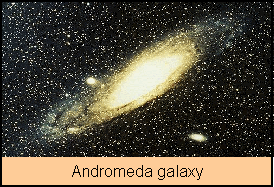Summary
This appears to be one of those Urantia Book errors in which the authors have simply used the current value since, for our 'framework in which to think' (P.1260) the true distance to Andromeda is of little consequence, but as an error that would quickly become widely known, its usefuness as an inhibitor of fundamentalism is quite large.
********
Astronomers use various types of standard candles or cosmic yardsticks to measure distances to stars and galaxies. One of these yardsticks is the class of stars known as the Cepheid variable stars. One of the apparent errors in The Urantia Book comes from using the distance to the Andromeda galaxy that astronomers held in the 1930's. This distance was determined using Cepheid variable stars in M31, also called the Andromeda galaxy.
Henrietta Leavitt, a Harvard astronomer, determined in 1917 that there is a direct relationship between the luminosity (brightness) of Cepheid variable stars and the length of their period. The longer between periods of peak brightness, the greater the absolute luminosity of these stars. Using this relationship, astronomers can determine the distance to other galaxies by noting the period and apparent luminosity of the Cepheid variable stars in these other galaxies.
In 1924, the well known astronomer Edwin Hubble presented a paper to the American Astronomical Society showing that M31, the great spiral galaxy in Andromeda, is about 750,000 light years from earth. This distance is now known to be about 2.2 million light years from earth. Hubble got the wrong distance to M31 because he was using Shapley's calibration of a period luminosity (P-L) relationship for Cepheid variable stars--which was in error because Shapley was unaware that there were actually two types of Cepheid variable stars (now known as Type 1 and Type 2 populations) having differing P-L relationships..
Discussing M31 (Andromeda) the authors of The Urantia Book inform us:
"This far-distant nebula is visible to the naked eye, and when you view it, pause to consider that the light you behold left those distant suns almost one million years ago." (P.170)
It is interesting that the authors extol the use of the Cepheid variable stars by astronomers to make this measurement: "In one group of variable stars the period of light fluctuation is directly dependent on luminosity, and knowledge of this fact enables astronomers to utilize such suns as universe lighthouses or accurate measuring points for the further exploration of distant star clusters. By this technique it is possible to measure stellar distances most precisely up to more than one million light-years." (P. 456)
When astronomers first started using the Cepheid variables as standard candles, two million light years was about the limit of distances they could measure using this technique due to atmospheric distortion. Now, with improved terrestrial telescopes and the now repaired space-based Hubble telescope, that range has been pushed out to 60 million light years or more. Recently, this improvement in seeing has enabled astronomers to measure the distance to a galaxy in the Virgo cluster. The distance actually measured using Cepheid variable stars in the M100 galaxy was 56 million light years. Being able to measure galaxies at this distance also allows astronomers to determine a value for Hubble's constant, which is important in determining the age of the universe.
As recently as five years ago, the value of Hubble's constant so obtained, when combined with so-called critical density measurements, indicated that the age of universe was less than 10 billion years. This was rather embarrassing because there were stars in globular clusters calculated to be as much as 13 or 14 billion years old. Will the cosmologists be able to apply another patch to keep the Big Bang theory limping along, or are their backs up against the wall?



